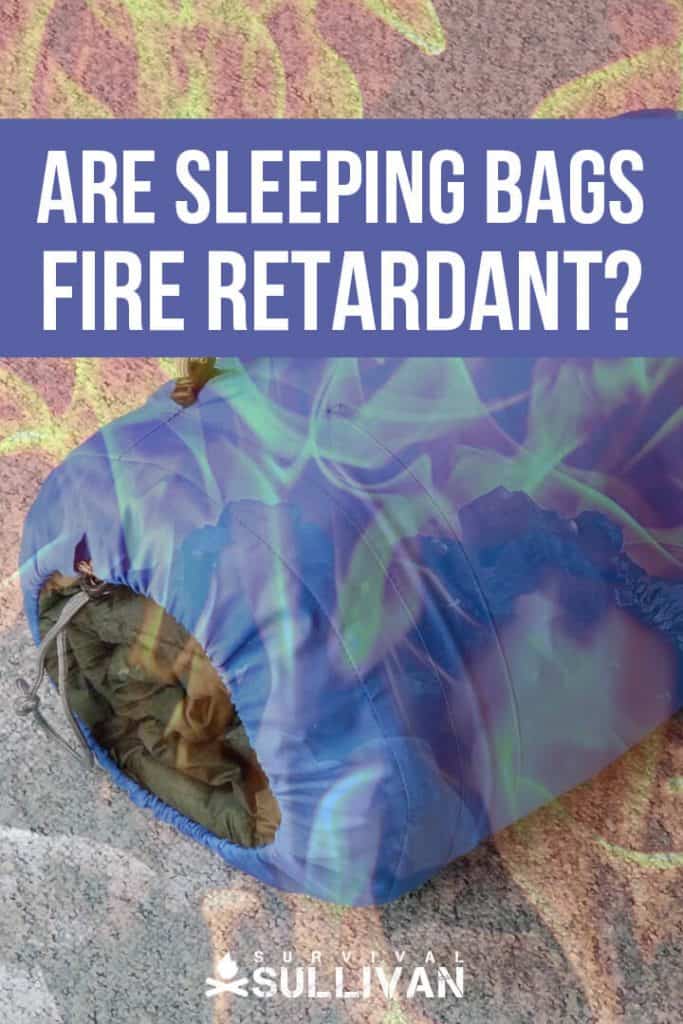If you are concerned about how flame-retardant your sleeping bag actually is, and what that little label really means in terms of protection should a fire break out in the campsite, then this article should clear up those questions.
A common fear is how much time there will be to escape before the whole sleeping bag ignites, and many people want to know whether all sleeping bags are flame-retardant – even those imported from other countries.
Yes, sleeping bags are required to be fire retardant. Government regulations require the fabric burn rate of all sleeping bags to be tested, as they are used around campfires, and where gas is used for cooking and lighting, involving flames putting campers at risk.
There is however a difference between a fabric being fire retardant and fire resistant, so let’s clear that up first.
Flame or fire resistance involves the structure of the material itself, like Kevlar for instance, which is tightly woven. The fabric will be resistant to catching fire, and should it catch fire, it won’t melt and drip onto the skin.
Flame- or fire-retardant fabric on the other hand involves treating a fabric – like cotton – with chemicals that will allow a small flame to self-extinguish rather than catching alight.
This means a flying ember from a crackling log fire won’t set a sleeping bag alight. Flame-retardant fabric should also not melt or drip when exposed to flame.
Tests of Flammability
The American Standard Test Method of Flammability the ASTM F1955 – 15 tests the flammability of fabrics used in the manufacture of sleeping bags.
It is similar to the test that the Industrial Fabrics Association International set when the organization was still known as the Canvas Products Association International – hence the name of the test – CPAI-75. The CPAI-75 test is an international one and applied to all sleeping bags imported into the US.
Washing, dry-cleaning and storage can affect burn rate
Now while it is acknowledged that when involved in an actual fire fabric may perform differently to the flame used for testing in a lab, at least standards can be set for the industry in terms of the burn rate of the fabric used.
To conduct the test, specimens are cut from actual sleeping bags, or a facsimile of the fabric layers used is obtained, then a standardized flame is applied to the new bag samples. Tests are also conducted on samples of the same bags that have been laundered a few times, and from those that have been dry-cleaned.
Samples are even taken from sleeping bags that have been stored packed tightly so the loft is compressed, then left for an hour to regain the loft. This way it can be determined if the burn rate of a particular sleeping bag is affected by washing, dry-cleaning or tight storage conditions.
What is the burn rate a sleeping bag must pass?
The minimum acceptable burn rate is 15cm (6 inches) per minute – any faster than this and the sleeping bag won’t pass certification as having met the burn rate requirement.
Even when it has been passed as flame-retardant the sleeping bag will still need a label saying that it must be kept away from open flames as it will still burn, but at a slower rate.
Chemicals used to make sleeping bags flame-retardant
Unfortunately making sleeping bags flame-retardant has come at a cost to the environment and Greenpeace has highlighted some of the issues.
Chemicals such as organohalogen, and organophosphates like polybrominated diphenyl ethers (PBDEs) and chlorinated tris (TDCPP) find their way into aquatic systems and marine animals, as well as into humans where they do not break down easily.
There are newer products being tested that are more environmentally friendly. Strange as it may sound these include casein, which comes from whey, a by-product of making cheese. Then scientists are looking at dopamine (best known as a neurotransmitter in the brain) obtained from marine mussels.
The mussels produce a dopamine-based substance that enables them to stick to rocks, and may perform well as a flame-retardant. Then it looks like the ocean has yet another possible answer – fiber from crushed crab shells, mixed with clay and DNA has also proven promising in research testing.
However, numerous lobbyists against chemical treatment of fabric point out that the flame-retardant properties will only protect a person from relatively minor incidences of burning.
If the fire is big the fabric will still burn, so don’t be complacent because a product is labelled as ‘flame retardant’, as this phrase is definitely not interchangeable with ‘fire-proof’. Caution should be taken when using a sleeping bag near any source of flame.


Traveler, photographer, writer. I’m eternally curious, in love with the natural world. How people can survive in harmony with nature has fueled my food safety and survival gardening practices.
At the age of 12, I found a newspaper advertisement for a 155-acre farm at a really good price and showed my parents one Sunday morning. They bought it and I happily started planting vegetables, peanuts, maize and keeping bees with the help of the local labor.
Once I married wherever we moved it was all about planting food, keeping chickens and ducks, permaculture and creating micro-climates. I learned how to build wooden cabins and outdoor furniture from pallets, and baked and cooked home-grown produce, developing recipes as I went along.
